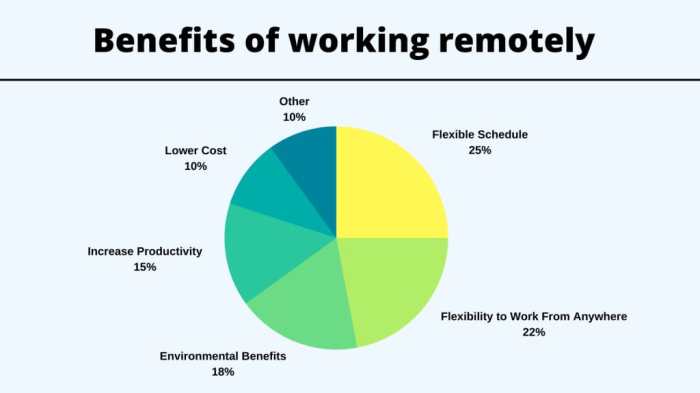Remote Work Productivity, a crucial aspect in today’s work landscape, involves maximizing efficiency while working from a distance. As businesses and individuals navigate the challenges of remote work, understanding how to enhance productivity is key to success.
Exploring the definition, factors, strategies, and tools related to remote work productivity provides valuable insights into optimizing performance in a virtual setting.
Definition of Remote Work Productivity

Remote work productivity refers to the level of effectiveness and efficiency at which individuals or teams are able to complete tasks, achieve goals, and produce results while working remotely, away from a traditional office setting. It involves utilizing tools, technologies, and strategies to maintain high levels of performance and output outside of a physical office environment.
Importance of Remote Work Productivity
- Increased Flexibility: Remote work productivity allows individuals to work at their own pace and during their most productive hours, leading to better work-life balance.
- Cost Savings: By eliminating the need for a physical office space, businesses can save on overhead costs and invest more resources into other areas of the company.
- Global Collaboration: Remote work productivity enables teams to collaborate across different time zones and locations, fostering diversity and innovation.
- Improved Employee Satisfaction: When employees have the flexibility to work remotely and maintain high productivity levels, they tend to be more satisfied with their jobs and perform better.
Examples of Remote Work Productivity Impact
- Increased Output: Companies that prioritize remote work productivity often see a boost in output levels as employees are able to focus without the distractions of a traditional office.
- Cost Efficiency: Businesses that embrace remote work productivity can reduce costs associated with office space, utilities, and commuting expenses, leading to higher profitability.
- Workforce Diversity: Remote work productivity allows companies to tap into a diverse talent pool from around the world, bringing in unique perspectives and skills to the team.
Factors Affecting Remote Work Productivity

When it comes to remote work productivity, several key factors play a crucial role in determining how efficient and effective employees can be while working from home. Factors such as technology, work environment, and work-life balance all contribute significantly to the overall productivity levels of remote workers.
Impact of Technology
Technology is a major influencer when it comes to remote work productivity. The availability of reliable internet connections, efficient communication tools, project management software, and other technological resources can greatly enhance or hinder a remote worker’s ability to perform their tasks effectively. When technology is seamless and user-friendly, employees can collaborate better, access necessary information quickly, and stay organized, ultimately leading to increased productivity.
Work Environment
The work environment also plays a critical role in remote work productivity. A designated workspace free from distractions, comfortable seating, proper lighting, and ergonomic equipment can significantly impact an employee’s focus and motivation levels. Creating a work environment that mimics an office setting can help remote workers separate work from personal life and maintain a professional mindset, thereby improving productivity.
Work-Life Balance
Maintaining a healthy work-life balance is essential for remote work productivity. Without clear boundaries between work hours and personal time, remote workers may struggle to disconnect from work and recharge, leading to burnout and decreased productivity. Establishing a routine, setting specific work hours, and taking regular breaks are crucial for ensuring that employees can balance their professional responsibilities with personal well-being, ultimately boosting productivity in a remote setting.
Strategies to Boost Remote Work Productivity
Working remotely comes with its own set of challenges, but there are several strategies you can implement to enhance your productivity and stay focused. Effective communication, time management, and minimizing distractions are key factors in ensuring you are making the most out of your remote work experience.
Effective Communication, Remote Work Productivity
Communication is crucial when working remotely as it helps to maintain connections with your team and ensures everyone is on the same page. Utilize various communication tools such as email, instant messaging, video calls, and project management platforms to stay connected and informed. Set clear expectations, establish regular check-ins, and be proactive in reaching out to colleagues when needed.
Time Management
Managing your time effectively is essential for remote work productivity. Create a daily schedule or to-do list outlining your tasks and priorities. Set specific work hours and take breaks to avoid burnout. Use time tracking tools to monitor your progress and identify areas where you can improve efficiency. Remember to set boundaries between work and personal life to maintain a healthy balance.
Minimizing Distractions
Distractions can easily derail your focus while working remotely, so it’s important to identify and minimize them. Designate a dedicated workspace that is free from distractions. Establish ground rules with family members or roommates to respect your work time. Use noise-canceling headphones or background music to block out any external noise. Limit your time on social media and other non-work-related websites to stay focused on your tasks.
Tools and Technologies for Remote Work Productivity
In today’s digital age, there are numerous tools and technologies specifically designed to enhance remote work productivity. These tools can help remote workers stay organized, communicate effectively, collaborate with team members, and manage tasks efficiently.
Essential Tools for Remote Work Productivity
- Communication Platforms: Tools like Slack, Microsoft Teams, and Zoom enable real-time communication and video conferencing, fostering seamless collaboration among remote team members.
- Project Management Software: Platforms such as Asana, Trello, and Monday.com help in organizing tasks, setting deadlines, tracking progress, and assigning responsibilities, thereby improving overall productivity.
- Cloud Storage Services: Services like Google Drive, Dropbox, and OneDrive allow remote workers to store, access, and share files securely from anywhere, ensuring smooth workflow and easy collaboration.
- Time Tracking Tools: Applications like Toggl, Harvest, and Clockify help remote workers monitor their time, analyze productivity patterns, and optimize work schedules for better efficiency.
Comparison of Productivity Tools for Remote Workers
- Slack vs. Microsoft Teams: While Slack is known for its user-friendly interface and integrations with various other tools, Microsoft Teams offers seamless integration with Microsoft Office applications and provides a comprehensive collaboration platform.
- Asana vs. Trello: Asana is preferred for its robust project management features and capabilities for complex workflows, whereas Trello is known for its simplicity and visual task management approach, suitable for smaller teams or personal projects.
- Google Drive vs. Dropbox: Google Drive offers easy collaboration features and integration with other Google Workspace apps, while Dropbox focuses more on file storage and sharing, with advanced security measures for sensitive data.
Benefits of Using Project Management Software
Project management software plays a crucial role in enhancing remote work productivity by providing a centralized platform for task management, communication, and collaboration. Some key benefits include:
Improved task organization and tracking, enhanced team transparency, streamlined communication, efficient resource allocation, better project visibility, and increased overall productivity.